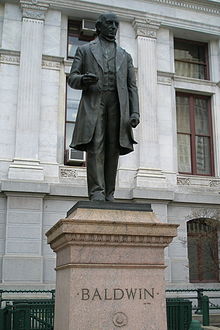- Matthias W. Baldwin
-
Matthias William Baldwin 
A statue of Baldwin in front of Philadelphia City HallBorn December 10, 1795
Elizabethtown, New JerseyDied September 7, 1866 (aged 70)
Philadelphia, Pennsylvania Historical marker commemorating the founding of the Baldwin Locomotive Works, in the Franklintown area of the Spring Garden neighborhood, Philadelphia.
Historical marker commemorating the founding of the Baldwin Locomotive Works, in the Franklintown area of the Spring Garden neighborhood, Philadelphia.
Matthias William Baldwin (December 10, 1795 – September 7, 1866) was an American manufacturer of steam locomotives. He opened his machine shop in 1825. The business grew to become Baldwin Locomotive Works, one of the most prolific and successful locomotive manufacturing firms in America.
Contents
Growth and early work: 1795–1832
Baldwin was born in Elizabethtown, New Jersey, the third of five children to a successful carriage builder. His father, William Baldwin, died in 1799.
In 1811 he entered an apprenticeship in Frankford, Pennsylvania, to learn jewelry making; he changed employers in 1817 to work with the company of Fletcher and Gardner in Philadelphia. Two years later, in 1819, he had used his jewelry-making knowledge to devise and patent a method for gold plating which has since become the standard method.
Baldwin moved on from jewelry making to bookbinding and printing. Foreshadowing his later success in the railroad industry, his printing shop in Philadelphia, Pennsylvania, was powered by a steam engine of his own design. Baldwin's printing business helped to reduce America's reliance on texts printed in Europe.
In 1825, Baldwin partnered with David Mason to open a machine shop in Philadelphia. His shop soon became known as one of the most able shops in the area.
Baldwin married a distant cousin in 1827, Sarah C. Baldwin. Together, they had three children.
Locomotive building: 1831–1866
Baldwin built his first locomotive in 1831 based on designs first shown at the Rainhill Trials in England. It was a small demonstration engine that was displayed at Peale's Philadelphia City Museum. The engine was strong enough to pull a few cars that carried four passengers each. This locomotive was unusual for the time in that it burned coal, which was available locally, instead of wood.
Baldwin's first railroad commission came in 1832 when his shop was asked to assemble a British-built steam locomotive, named Delaware, for the Newcastle and Frenchtown Railroad. The knowledge he gained through assembling this locomotive and from building his own stationary steam engines was transferred into construction of new locomotives.
Later in 1832, the same year that he assembled Delaware, Baldwin built his first new steam locomotive, Old Ironsides. It was first tested on November 23, 1832. This locomotive was a 2-2-0 (Whyte notation) type, meaning it had one unpowered leading axle and one powered driving axle, but Baldwin soon started building 4-2-0 types that were better suited to early American railroads.
Through the Baldwin Locomotive Works, which he founded soon after building Old Ironsides, Baldwin built more than 1,500 steam locomotives before his death in 1866. Zerah Colburn did much to publicise the work of the Baldwin Locomotive Works through his newspaper, the Railroad Advocate.
Philanthropy
Starting in 1824, Baldwin showed a willingness to give to charitable causes. In that year he was a founder of the Franklin Institute for the Betterment of Labour. In 1835 he donated money to form a school for African-American children in Philadelphia, and he was one of the early proponents of allowing black men to vote. His charitable and abolitionist stance, however, led to a boycott of Baldwin locomotives by railroads in the southern United States in the years before the Civil War.
One of his last philanthropic efforts was the donation of 10% of his company's (Baldwin Locomotive Works) income to the Civil War Christian Mission in the early 1860s.
Patents
- U.S. Patent 54 Art of Managing and Supplying Fire for Generating Steam in Locomotive-Engines. Issued to Matthias W. Baldwin on October 15, 1836. The intention of this new mode of managing the fire is to enable me, at each water station, or any convenient place to have a clear coal fire waiting the arrival of the engine so that the grate or fire-place which has been in use, may be detached or slid out, and that containing the clear fire, made to occupy its place.
References
Works cited
Further reading
- Brown, John K. (2001). The Baldwin Locomotive Works, 1831-1915: A Study in American Industrial Practice. Johns Hopkins University Press. ISBN 0-8018-6812-2.
- Baldwin Locomotive Works (1897). History of the Baldwin Locomotive Works from 1831 to 1897. Philadelphia: J. B. Lippincott Company. http://books.google.com/books?id=c7xBAAAAIAAJ&printsec=titlepage.
- Westing, Frederick (1966; reprinted 1982). The locomotives that Baldwin built. Containing a complete facsimile of the original "History of the Baldwin Locomotive Works, 1831-1923". Crown Publishing Group. ISBN 978-0517361672. LCCN 66-25422.
- Matthias W. Baldwin. Retrieved January 7, 2005.
- Mitchell, Frank (March 1999), M. W. Baldwin. Retrieved February 15, 2005.
- Schleis, Paula, Akron Beacon Journal (May 2, 2005), Baldwin locomotive builder left English in dust (republished by the BLE). Retrieved May 5, 2005.
- White, John H., Jr. (1968). A history of the American locomotive; its development: 1830-1880. New York, NY: Dover Publications. ISBN 0-486-23818-0.
- Mortimer, John. (2005) Zerah Colburn: The Spirit of Darkness. Arima Publishing, Bury St. Edmunds, IP32 6BB, UK. ISBN 1-84549-024-X
Categories:- 1795 births
- 1866 deaths
- Elizabeth, New Jersey
- Locomotive builders and designers
- American Civil War industrialists
- People from Elizabeth, New Jersey
- People from Philadelphia, Pennsylvania
- American railroad pioneers
- National Inventors Hall of Fame inductees
Wikimedia Foundation. 2010.
